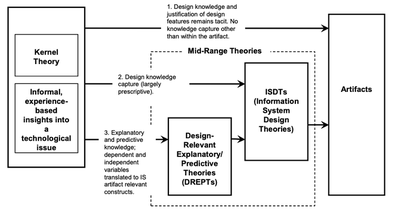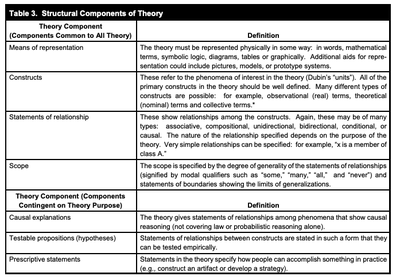Kernel Theory
What is a Kernel Theory?
Edited by Bijan Khosrawi-Rad and Anna Lux
The Question of WHY: Kernel Theories to Explain the Artifact
In general, a theory is understood as a collection of general statements about certain phenomena, i.e., about a specific segment of the real world (Popper 1959). Theories allow us to distinguish and structure facts; they help in understanding phenomena by providing a basis for explanations or predictions (Walls et al. 1992).
In the context of designing the DSR artifact, an explanation is needed for why an artifact is constructed the way it is and why it functions (Kuechler and Vaishnavi 2008). The question of “why” can be answered by theories: they provide foundational knowledge about how, for example, (material) objects behave, how processes and goals are interconnected, or how forms and materials influence each other. These theories that explain phenomena are called “kernel theories” and are drawn from disciplines outside of Information Systems (IS) as well as from existing insights of IS research. Depending on the artifact, kernel theories can vary in degree, depth, and origin, and can relate to products or processes, things or people. They stem, for example, from natural sciences, social sciences, behavioral sciences, or design (Gregor and Jones 2007, Kuechler and Vaishnavi 2008).
Kernel Theories as Contributions to Design Theory
Within the literature on design-oriented research in Information Systems, there are different opinions about the relationship between artifact, design theories, and kernel theories (Fischer et al. 2010). On one hand, the construction of the artifact can build upon existing kernel theories, thus justifying the artifact. Furthermore, kernel theories within the project may need to be further developed to adapt to the context before the artifact can be developed based on this extended version. In this intermediate step, the kernel theories become so-called “mid-range theories,” which serve as a significant contribution to design theory and go beyond an explanatory function (Kuechler and Vaishnavi 2012). Moreover, the question arises whether design theories themselves can become kernel theories.

Ultimately, Walls et al. (1992), Gregor (2006), Gregor and Jones (2007), as well as Kuechler and Vaishnavi (2008, 2012) regard kernel theories as an essential component of design theories and have influenced many DSR projects in recent years accordingly. For authors like Hevner et al. (2004), March and Smith (1995), or Goldkuhl (2004), the use of kernel theories is not mandatory; however, employing them can be helpful and sensible. Ultimately, the decision lies with you and depends on the character of your DSR project. Resorting to applicable knowledge from theories, frameworks, or methods can help you ensure rigor. Considering kernel theories can lead to a better design of your artifact and additionally provide a basis for scientific grounding.
Examples of Kernel Theories
- Chiang and Mookerjee (2004) build their error threshold policy on knowledge about group coordination processes, team cognition, software development productivity, and error growth models.
- A recent example from human-computer interaction can be found in Diederich et al. (2022): In this publication, kernel theories for the design of conversational agents are presented as part of the literature analysis.
Step by Step to Finding the Appropriate Kernel Theories
But how do I find the kernel theories for my research area? This primarily requires literature work. Systematic literature analyses are an appropriate way in the context of DSR to capture literature on a current research topic. A structured coding of the collected literature with MAXQDA or Excel allows for the theories to be recorded systematically. It is advisable to analyze the theoretical sections (often called “Theoretical Grounding” in many publications) of the existing literature related to the research complex concerning references to fundamental theories. By doing this systematically, it is possible to identify where certain research streams originate and where they might lead in the future. In extensive literature analyses, it is useful to cluster these theories afterward if many theories come from similar areas.
Even though a structured approach is the common way, it is not the only possibility: A semi-structured literature analysis also offers a way to quickly capture suitable theories with precisely chosen search criteria in scientific databases. It is important to use a variety of databases and search terms/combinations of search terms: Since kernel theories can come from various disciplines (e.g., social sciences, psychology), a search limited solely to Information Systems research databases might not comprehensively cover the research field. Therefore, for an interdisciplinary analysis, it is necessary to define from which disciplines kernel theories for a research area might come, identify suitable databases for these various areas, and then establish appropriate search terms as well as inclusion and exclusion criteria. For example, if one wants to identify kernel theories for chatbots supporting students, databases from disciplines such as computer science, information systems, human-computer interaction, media studies, social sciences, psychology, or pedagogy could provide insights. An appropriate framework to simplify this search process for planning the research is offered by Schoorman et al. (2021).
However, caution is advised: Not every identified theory is necessarily a kernel theory. Thus, it should first be checked whether the components of a theory are fulfilled at all. Gregor (2006) presents various components for this purpose:

Furthermore, it is important to note that not every theory can be transferred one-to-one to another research context. For example, theories of human-human relationships can serve to explain phenomena of human-machine relationships; however, this changed contextual environment may possess additional variables that influence the applicability of the theory. Vaishnavi & Kuechler (2015, p. 92) write about this:
“Beyond that, we propose that ‘kernel theories’ from other fields are often so narrowly derived as to be more suggestive than useful as given, and that refinement of the theory in the act of development is required to give the theory direct applicability to IS design efforts (Carroll and Kellogg, 1989).”
Therefore, it is important to examine the transferability of the theories to your own research context, make adjustments if necessary, and evaluate and revise the design knowledge developed based on the kernel theories through further studies. This can be achieved by involving experts through interviews or workshops, as well as evaluating the designed artifacts with potential users.
References
- Fischer, C., Winter, R. & Wortmann, F., 2010, Design Theory
- Goldkuhl, 2004, Design Theories in Information Systems - a Need for Multi-Grounding
- Gregor, 2006, The Nature of Theory in Information Systems
- Gregor & Jones, 2007, The Anatomy of a Design Theory
- Hevner et al., 2004, Design Science in Information Systems Research
- Kuechler & Vaishnavi, 2008, On Theory Development in Design Science Research – Anatomy of Research Project
- Kuechler & Vaishnavi, 2012, A Framework for Theory Development in Design Science Research: Multiple Perspectives
- March & Smith, 1995, Design and Natural Science Research on Information Technology
- Vaishnavi & Kuechler, 2015, Design Science Research Methods and Patterns: Innovating Information and Communication Technology
- Walls et al., 1992, Building an Information System Design Theory for Vigilant EIS